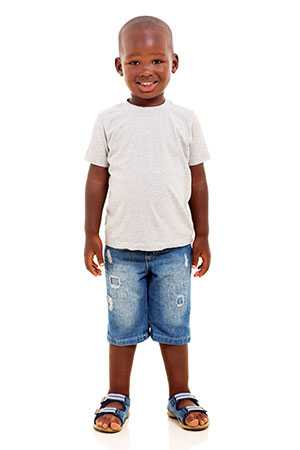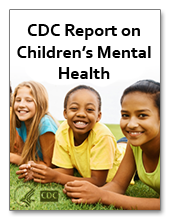Preschoolers (3-5 years of age)

Developmental Milestones
Skills such as naming colors, showing affection, and hopping on one foot are called developmental milestones. Developmental milestones are things most children can do by a certain age. Children reach milestones in how they play, learn, speak, behave, and move (like crawling, walking, or jumping).
As children grow into early childhood, their world will begin to open up. They will become more independent and begin to focus more on adults and children outside of the family. They will want to explore and ask about the things around them even more. Their interactions with family and those around them will help to shape their personality and their own ways of thinking and moving. During this stage, children should be able to ride a tricycle, use safety scissors, notice a difference between girls and boys, help to dress and undress themselves, play with other children, recall part of a story, and sing a song.
Positive Parenting Tips
Following are some of the things you, as a parent, can do to help your preschooler during this time:
- Continue to read to your child. Nurture her love for books by taking her to the library or bookstore.
- Let your child help with simple chores.
- Encourage your child to play with other children. This helps him to learn the value of sharing and friendship.
- Be clear and consistent when disciplining your child. Explain and show the behavior that you expect from her. Whenever you tell her no, follow up with what he should be doing instead.
- Help your child develop good language skills by speaking to him in complete sentences and using “grown up” words. Help him to use the correct words and phrases.
- Help your child through the steps to solve problems when she is upset.
- Give your child a limited number of simple choices (for example, deciding what to wear, when to play, and what to eat for snack).
Positive Parenting Tip Sheet
Child Safety First
As your child becomes more independent and spends more time in the outside world, it is important that you and your child are aware of ways to stay safe. Here are a few tips to protect your child:
- Tell your child why it is important to stay out of traffic. Tell him not to play in the street or run after stray balls.
- Be cautious when letting your child ride her tricycle. Keep her on the sidewalk and away from the street and always have her wear a helmet.
- Check outdoor playground equipment. Make sure there are no loose parts or sharp edges.
- Watch your child at all times, especially when he is playing outside.
- Be safe in the water. Teach your child to swim, but watch her at all times when she is in or around any body of water (this includes kiddie pools).
- Teach your child how to be safe around strangers.
- Keep your child in a forward-facing car seat with a harness until he reaches the top height or weight limit allowed by the car seat’s manufacturer. Once your child outgrows the forward-facing car seat with a harness, it will be time for him to travel in a booster seat, but still in the back seat of the vehicle. The National Highway Traffic Safety Administration has information on how to keep your child safe while riding in a vehicle.

Healthy Bodies
- Eat meals with your child whenever possible. Let your child see you enjoying fruits, vegetables, and whole grains at meals and snacks. Your child should eat and drink only a limited amount of food and beverages that contain added sugars, solid fats, or salt.
- Limit screen time for your child to no more than 1 to 2 hours per day of quality programming, at home, school, or child care.
- Provide your child with age-appropriate play equipment, like balls and plastic bats, but let your preschooler choose what to play. This makes moving and being active fun for your preschooler.
For More Information
CDC’s “Learn the Signs. Act Early.” Campaign
For more details on developmental milestones, warning signs of possible developmental delays, and information on how to help your child’s development, visit the “Learn the Signs. Act Early.” campaign website.
CDC’s Parent Information (Children 0―3 years)
This site has information to help you learn how to give your child a healthy start in life.
CDC’s Essentials for Parenting Toddlers and Preschoolers
Learn ways you can help build a safe, stable, and nurturing relationship with your child.
CDC’s Breastfeeding Information.
This site has answers to frequently asked questions about breastfeeding.
CDC’s Healthy Weight Information.
Tips for Parents – Ideas to help children maintain a healthy weight.
CDC’s Protect the Ones You Love
CDC’s Injury Center has information on how you can protect your child from drowning and other common causes of injury.
Bright Futures
Bright Futures provides information on what to expect as your baby grows, including parenting tips. Patient/parent education handouts are available for your child’s regular check-up visit with your healthcare provider from 2-5 days of age until 18-21 years of age.
Choose My Plate- Preschoolers
The U.S. Department of Agriculture provides information on health and nutrition for 2 through 5 years of age.
HealthyChildren.org
AAP’s Healthy Children website provides information on feeding, nutrition, and fitness for all developmental stages from infancy to young adulthood.
Just in Time Parenting (JITP)
Quality, research-based information to families at the time it can be most useful.
Let’s Move – Child Care
You will find information on physical activity for young children and on ways to keep them moving.
National Highway Traffic Safety Administration (NHTSA)
NHTSA has information on safety recalls and safety tips for children riding in motor vehicles, walking, biking, playing outside, waiting at school bus stops, and more.
National Institute of Child Health and Human Development. (NICHD)
Visit NICHD to learn how to reduce the risk of Sudden Infant Death Syndrome (SIDS) and about safe sleep environments.
Vaccines
View the child immunization schedule and find out if your child’s vaccinations are up to date.
World Health Organization information on infant nutrition
This site has information to promote proper feeding for infants and young children.
CDC’s “Learn the Signs. Act Early.” Campaign
For more details on developmental milestones, warning signs of possible developmental delays, and information on how to help your child’s development, visit the “Learn the Signs. Act Early.” campaign website.
CDC’s Parent Information (Children 4−11 years)
This site has information to help you guide your child in leading a healthier life.
CDC’s Essentials for Parenting Toddlers and Preschoolers
Learn ways you can help build a safe, stable, and nurturing relationship with your child.
CDC’s Healthy Weight Information.
Tips for parents – Ideas to help children maintain a healthy weight.
Bright Futures
Bright Futures provides information on what to expect as your baby grows, including parenting tips. Patient/parent education handouts are available for your child’s regular check-up visit with your healthcare provider from 2-5 days of age until 18-21 years of age.
Building Blocks
SAMHSA’s Building Blocks help parents, caregivers, and educators of children ages 3 to 6 in creating safe, supportive, and nurturing environments for young children to help them grow up mentally healthy and drug-free.
Choose My Plate- Preschoolers
The U.S. Department of Agriculture provides information on health and nutrition for children 2 through 5 years of age.
HealthyChildren.org
AAP’s Healthy Children website provides information on feeding, nutrition, and fitness for all developmental stages from infancy to young adulthood.
Just in Time Parenting (JITP)
Quality, research-based information to families at the time it can be most useful.
Let’s Move – Child Care
You will find information on physical activity for young children and on ways to keep them moving.
National Highway Traffic Safety Administration (NHTSA)
NHTSA has information on safety recalls and safety tips for children riding in motor vehicles, walking, biking, playing outside, waiting at school bus stops, and more.
CDC’s Parent Information (Children 4 — 11 years)
This site has information to help you guide your child in leading a healthier life.
CDC’s Healthy Weight Information.
Tips for parents – Ideas to help children maintain a healthy weight.
CDC’s Youth Physical Activity Guidelines Toolkit
This site has information on how to help children be active and play.
KidsQuest
KidsQuest is a CDC website designed for students in fourth, fifth, and sixth grades, to get them to think about people with disabilities and some of the issues related to daily activities, health, and accessibility.
BAM! Body and Mind
CDC’s BAM! Body and Mind is a website designed for kids 9 through 13 years of age to give them the information they need to make healthy lifestyle choices. The site focuses on topics that kids told us are important to them—such as stress and physical fitness—using kid-friendly lingo, games, quizzes, and other interactive features.
Bright Futures
Bright Futures provides information on what to expect as your baby grows, including parenting tips. Patient/parent education handouts are available for your child’s regular check-up visit with your healthcare provider from 2-5 days of age until 18-21 years of age.
Choose My Plate – Children over 5.
The U.S. Department of Agriculture provides information on health and nutrition for children over 5 years of age.
HealthyChildren.org
AAP’s Healthy Children website provides information on feeding, nutrition, and fitness for all developmental stages from infancy to young adulthood. Visit this website to learn more about emotional problems, learning disabilities and other health and development concerns.
Just in Time Parenting (JITP)
Quality, research-based information to families at the time it can be most useful.
Let’s Move-Parents
Five simple steps for parents towards creating a healthy environment at home.
National Highway Traffic Safety Administration (NHTSA)
NHTSA has information on safety recalls and safety tips for children riding in motor vehicles, walking, biking, playing outside, waiting at school bus stops, and more.
StopBullying.gov
StopBullying.gov provides information from various government agencies on how kids, teens, young adults, parents, educators and others in the community can prevent or stop bullying.
SAMHSA’s KnowBullying app
A free app for parents to help prevent bullying, created by the Substance Abuse and Mental Health Agency (SAMHSA).
Teens Health
Visit this site for information on healthy eating and exercise for children and teenagers, safety tips for your child at home when you can’t be there, and other important health and safety topics.
CDC’s Parent Information (Teens 12— 19)
This site has information to help you learn how to guide your teen to be safe and become a healthy and productive adult.
CDC’s Healthy Weight Information.
Tips for parents – Ideas to help children maintain a healthy weight.
CDC’s Pregnancy Prevention for Teens.
Tips and information especially for teens and designed with input from teens.
American Academy of Child & Adolescent Psychiatry
The American Academy of Child & Adolescent Psychiatry has many fact sheets for parents on child and adolescent health and development.
BAM! Body and Mind
CDC’s BAM! Body and Mind is a website designed for kids 9 through13 years of age, to give them the information they need to make healthy lifestyle choices. The site focuses on topics that kids told us are important to them—such as stress and physical fitness—using kid-friendly lingo, games, quizzes, and other interactive features.
Bright Futures
Bright Futures provides information on what to expect as your baby grows, including parenting tips. Patient/parent education handouts are available for your child’s regular check-up visit with your healthcare provider from 2-5 days of age until 18-21 years of age.
Choose My Plate
The U.S. Department of Agriculture provides information on health and nutrition.
HealthyChildren.org
AAP’s Healthy Children website provides information on feeding, nutrition, and fitness for all developmental stages from infancy to young adulthood.
Just in Time Parenting (JITP)
Quality, research-based information to families at the time it can be most useful.
Let’s Move-Kids
Five simple steps for kids towards growing up healthy.
National Highway Traffic Safety Administration (NHTSA)
NHTSA has information on safety recalls and safety tips for children riding in motor vehicles, walking, biking, playing outside, waiting at school bus stops, and more.
National Institute of Mental Health
The National Institute of Mental Health has information on mental disorders affecting children and adolescents, including anxiety and depression.
StopBullying.gov
StopBullying.gov provides information from various government agencies on how kids, teens, young adults, parents, educators, and others in the community can prevent or stop bullying.
SAMHSA’s KnowBullying app
A free app for parents to help prevent bullying, created by the Substance Abuse and Mental Health Agency (SAMHSA).
Substance Abuse and Mental Health Services Administration (SAMHSA)
SAMHSA works to improve the quality and availability of substance abuse prevention, alcohol and drug addiction treatment, and mental health services.
Teens Health
Visit this site for information on healthy eating and exercise for children and teenagers.
- Page last reviewed: February 1, 2017
- Page last updated: January 3, 2017
- Content source:
- Division of Human Development and Disabilities, National Center on Birth Defects and Developmental Disabilities, Centers for Disease Control and Prevention



 ShareCompartir
ShareCompartir